According to the U.S. Bureau of Justice Statistics, every year about 3.7 million burglaries are committed in America. Roughly 28 percent of those burglaries take place while someone is present in the home and about 7 percent result in violent victimization of a resident. While those figures aren’t staggering, they aren’t particularly comforting either, especially if one of those unlucky homes happens to be yours. If you’re reading this magazine, odds are you already have some type of plan to deal with a potential home invader. Whether it’s accessing a weapon, hunkering down in a safe room, or a little of both, the key to implementing that plan is time. The longer it takes you to react and get your strategy in motion, the less likely it will be successful and the greater your chances of becoming a victim. However, when you consider the fact that 61 percent of burglaries of occupied residences occur at night and 38 percent while the residents are asleep, your visions of a perfectly choreographed split-second reaction plan start to fade pretty quickly. So how can you stack the odds in your favor by earning more reaction time? Easy. With perimeter defense tools.
Types of Perimeter Defense Tools
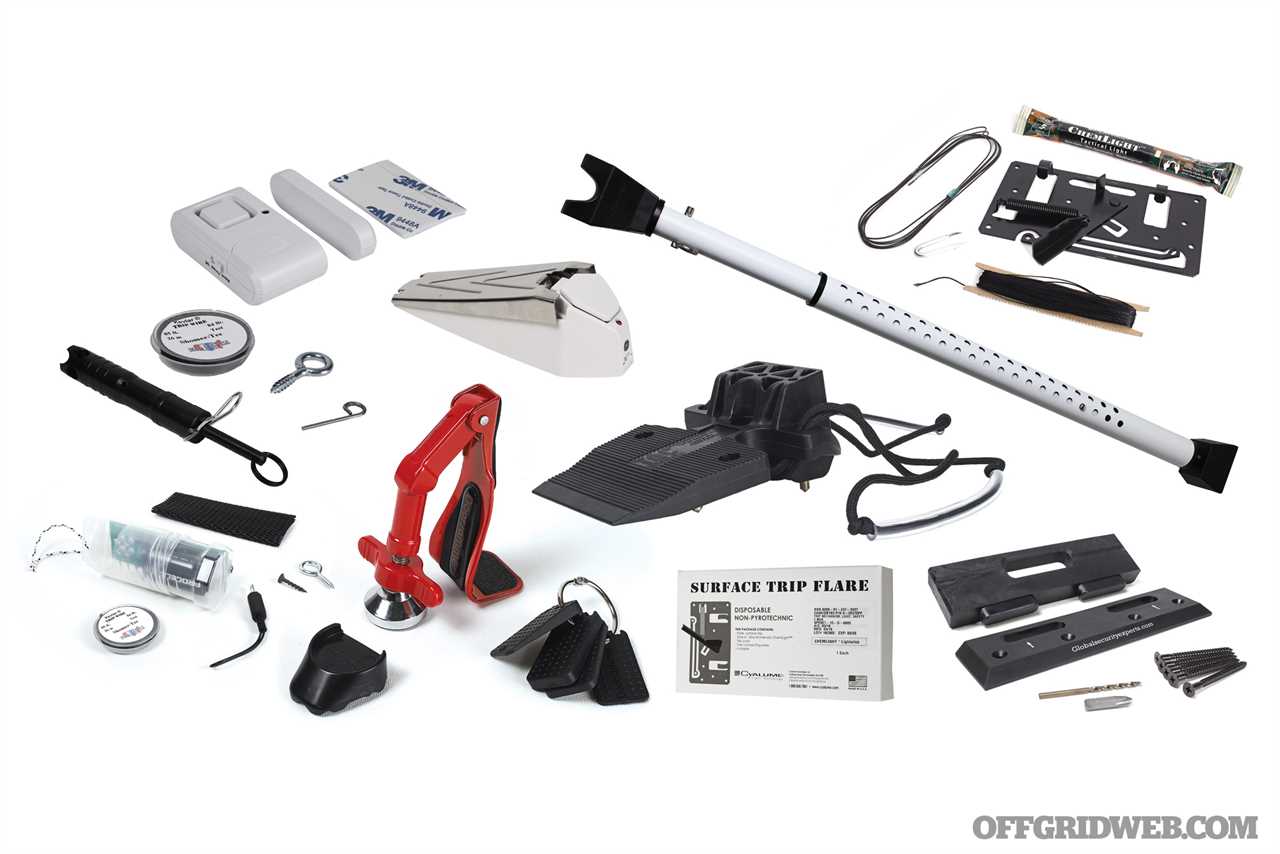
In simple terms, perimeter defense tools are passive devices designed to either bolster the physical security of your home or provide early warning of a security breach so you can drag your sleepy ass out of bed and get into fight mode. Technology-wise, they run the gamut from dead-simple objects like door wedges to sophisticated wireless alarms and infrared trip flares. Generally, however, they can be classified in three basic categories:
Physical barriers – These items reinforce the structural strength of doors or windows and either deny the bad guy access altogether or slow down his entry while making it a whole lot noisier. While the effectiveness of these products depends heavily on the doors they’re trying to strengthen, they offer both enhanced physical security and a form of early warning alarm.
Overt alarms – These alarms announce a perimeter breach to you, the bad guy, and everyone else in the area. In a residential context, these devices give you a head’s up to the threat and may be enough of a deterrent to cause the bad guy to cut and run. If your neighbors hear the alarm, they can also get involved by calling 9-1-1 and being good witnesses.
Covert alarms – These devices alert you to a perimeter breach without alerting your uninvited guest. As an auditory alarm that only you can hear, these devices can give you a useful edge. Visual covert alarms, however, are only useful if you are actively observing them when they are tripped.
Our Perimeter Defense Tool Buyer's Guide

The type or types of devices that are best for your needs depends upon the nature of your residence. If you live in the country on several acres of land, trip flares and trail guards could be a useful component of your perimeter defense plan. In a hotel room, vacation rental, or apartment, door wedges and stick-on alarms are much more appropriate.
No matter where you may call home, always make the physical security of all points of entry your first priority. The harder it is for a would-be intruder to get in, the more noise he’ll make in the process and the less tempted he’ll be to try in the first place. Many exterior doors — even those equipped with deadbolt locks — will not withstand a hard kick, so alarms that alert you to a breach of that perimeter still only give you a few seconds to react. As such, alarms should always be considered a supplement to physical security, never a replacement for it. Nevertheless, to be forewarned is to be forearmed, so let’s look at some of the technology that can help us achieve that goal.
Pro1Tek TAC-Wedge Plus
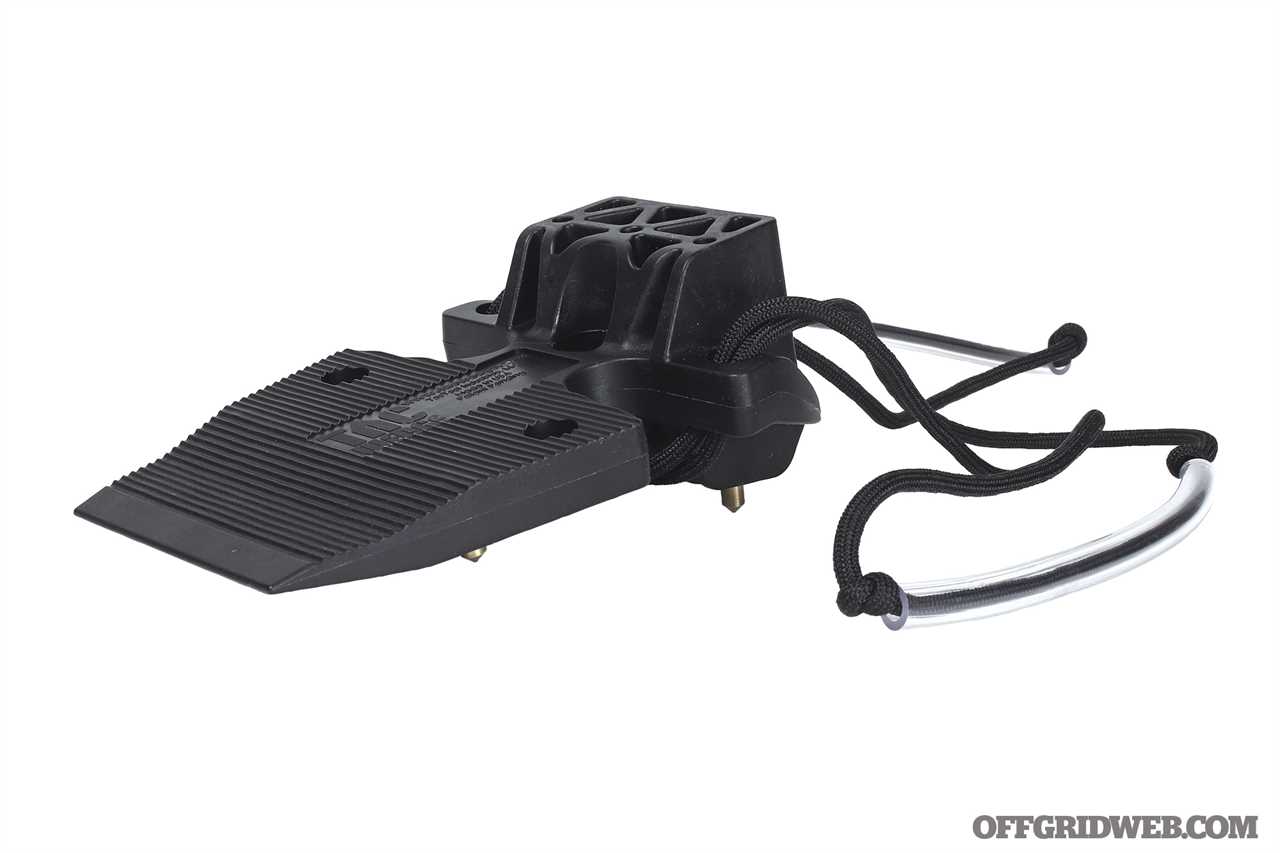
Above: The TAC-Wedge Plus is a doorstop on steroids that includes hardened steel spikes on the bottom to ensure it bites into the floor to hold fast.
Category: Physical Barrier
Dimensions: 5.40 by 3.50 by 2.26 inches
Weight: 6.4 ounces
Price: $29
URL: pro1tek.com
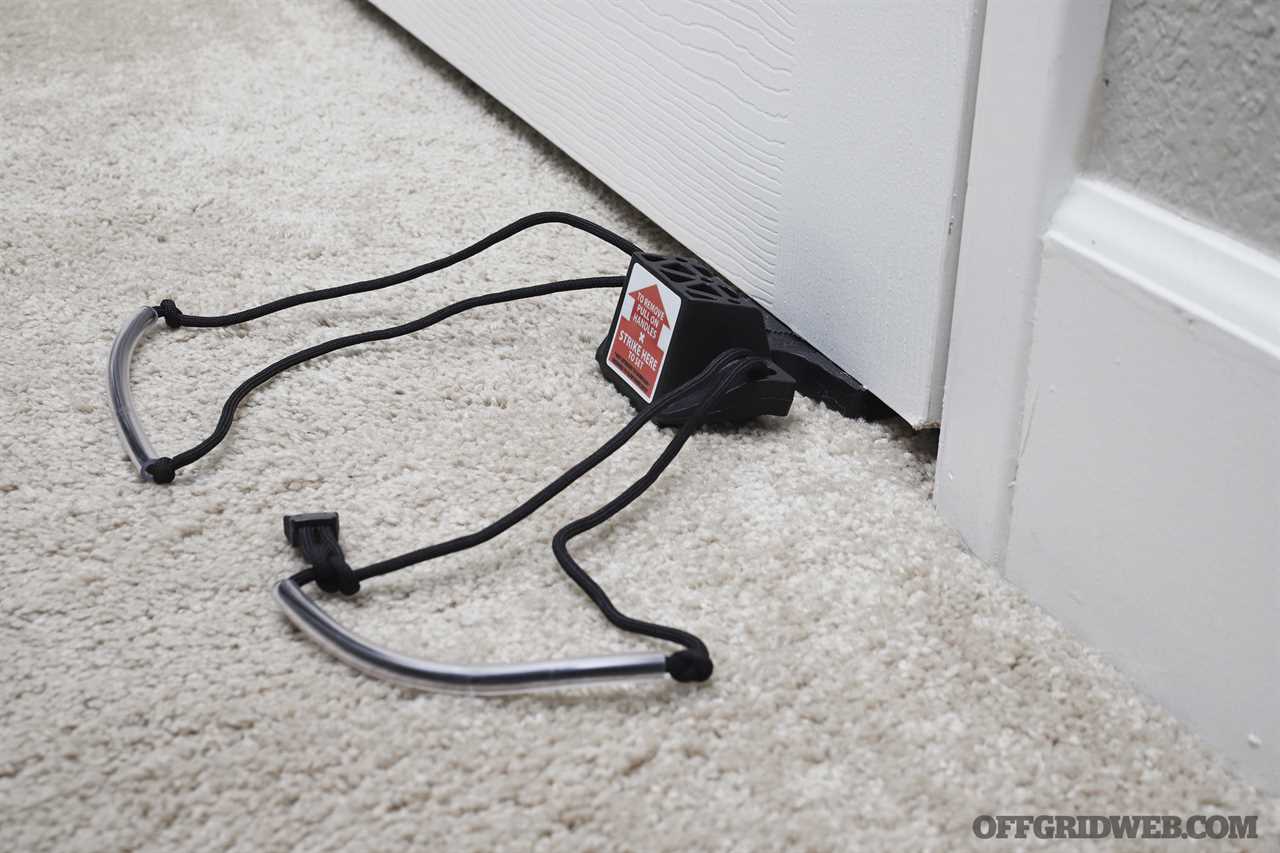
Above: To be effective, the TAC-Wedge Plus requires some space under the door. Its spikes are also not friendly to floors.
Notes:
This multi-function doorstop on steroids can be used to hold doors open, keep them shut, or make them almost impenetrable. When hammered or kicked into place under an inward-opening door, its four hardened steel spikes bite hard into the floor and make the door practically impossible to open. This makes it perfect for securing non-locking doors or reinforcing doors that do lock — provided there’s at least a small gap between the bottom of the door and the threshold. The design includes paracord loops to help remove it after use, but its instructions recommend using a baton or similar handle with the loops for added leverage. Although very effective in an emergency situation, the device’s steel spikes are not friendly to floors and will scratch them deeply if the device is used. As such, it doesn’t lend itself well to repetitive use as a regular home security feature. For interior doors that swing over carpeted floors — like a bedroom safe room — it’s more forgiving and could have some utility. It is not well suited to use on exterior doors, especially those with weatherstripping that are fit tight to the threshold. Finally, like all doorstop-style devices, the ultimate effectiveness of the TAC-Wedge Plus also depends on the structural strength of the door itself. If your bedroom has a hollow-core door that an angry 12-year-old can punch through, no doorstop will change that. For a teacher in a school active-shooter scenario, this product is awesome. As an element of a long-term home-defense plan, its potential is more limited.
Von Saint DoorJammer: Portable

Above: The DoorJammer kit includes a series of wedges to fill the gap at the top of a door and a stout screw-style doorstop that installs at the bottom.
Category: Physical Barrier
Dimensions: 4.37 by 2.36 by 2.80 inches
Weight: 8.8 ounces (with accessories)
Price: $30
URL: door-jammer.com
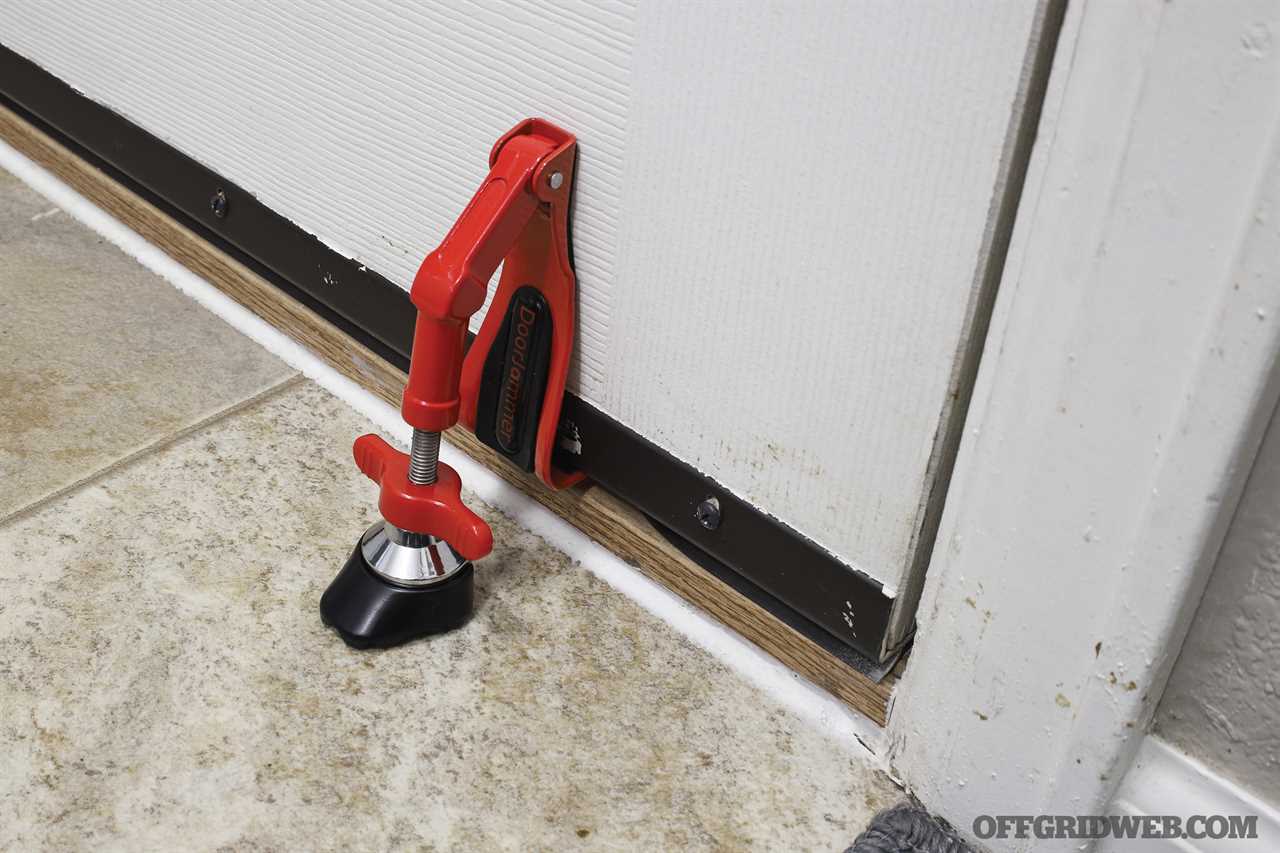
Above: The DoorJammer works well even on exterior doors with weather stripping at the bottom. However, it still relies on the strength of the door itself.
Notes:
Designed primarily for travelers for use in hotel rooms, this device consists of two steel pieces connected by a hinge. To use it, hook the base of the L-shaped piece under the bottom of an inward-opening door and turn the knob on the other piece to extend the threaded “foot.” When the foot reaches the floor, a few more turns wedges the DoorJammer tightly in place. Horizontal pressure on the door — like someone trying to push it in — redirects the energy downward into the floor to hold the door fast. For doors with significant space at the top or bottom, it comes complete with a set of rubber spacers and a molded extension foot to take up the slack. To remove the DoorJammer, simply rotate the knob to retract the foot or, in an emergency, just pull the whole unit upward. This device is made of sturdy metal and features rubber pads and friction tape on all its key contact surfaces so it can be installed and removed repeatedly without marring the door or floor. That quality makes it suitable for regular use in a home-security role, especially for apartments and rental properties where you may not be able to make permanent changes to the structure to bolster security. With that said, the DoorJammer is still only viable if the door it’s securing has a reasonably solid structure. If the doors in your home do, you might consider upgrading from the travel-sized version to the DoorJammer: Lockdown, which is about twice the size and designed for more strategic residential or office use. It retails for $50.
Global Security Experts OnGARD
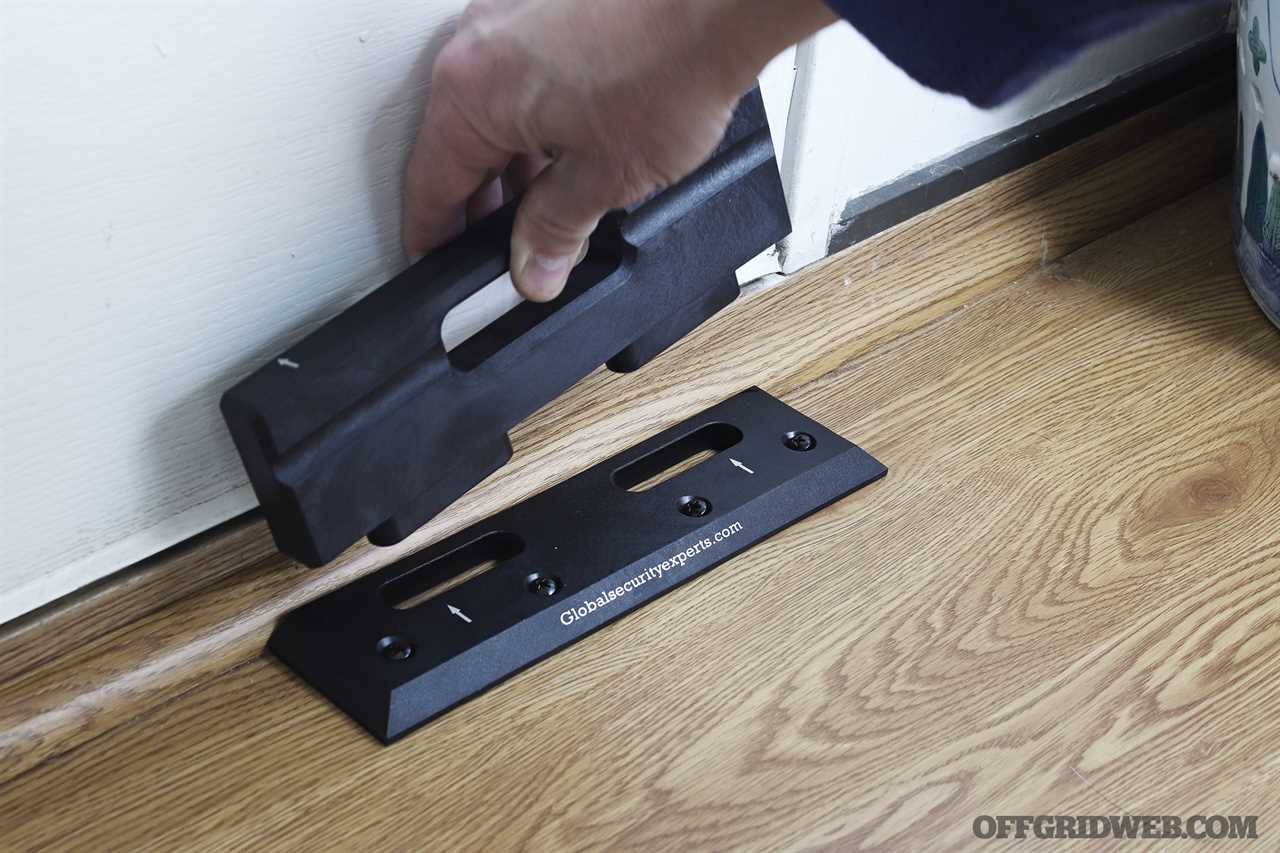
Above: Inserting the OnGARD’s top plate into the slots in the base plate.
Category: Physical Barrier
Dimensions: Bottom Plate: 10 by 2.5 by 0.5 inches; Top Plate: 9.25 by 1.0 by 2.75 inches
Weight: 1.12 pounds
Price: $119
URL: globalsecurityexperts.com
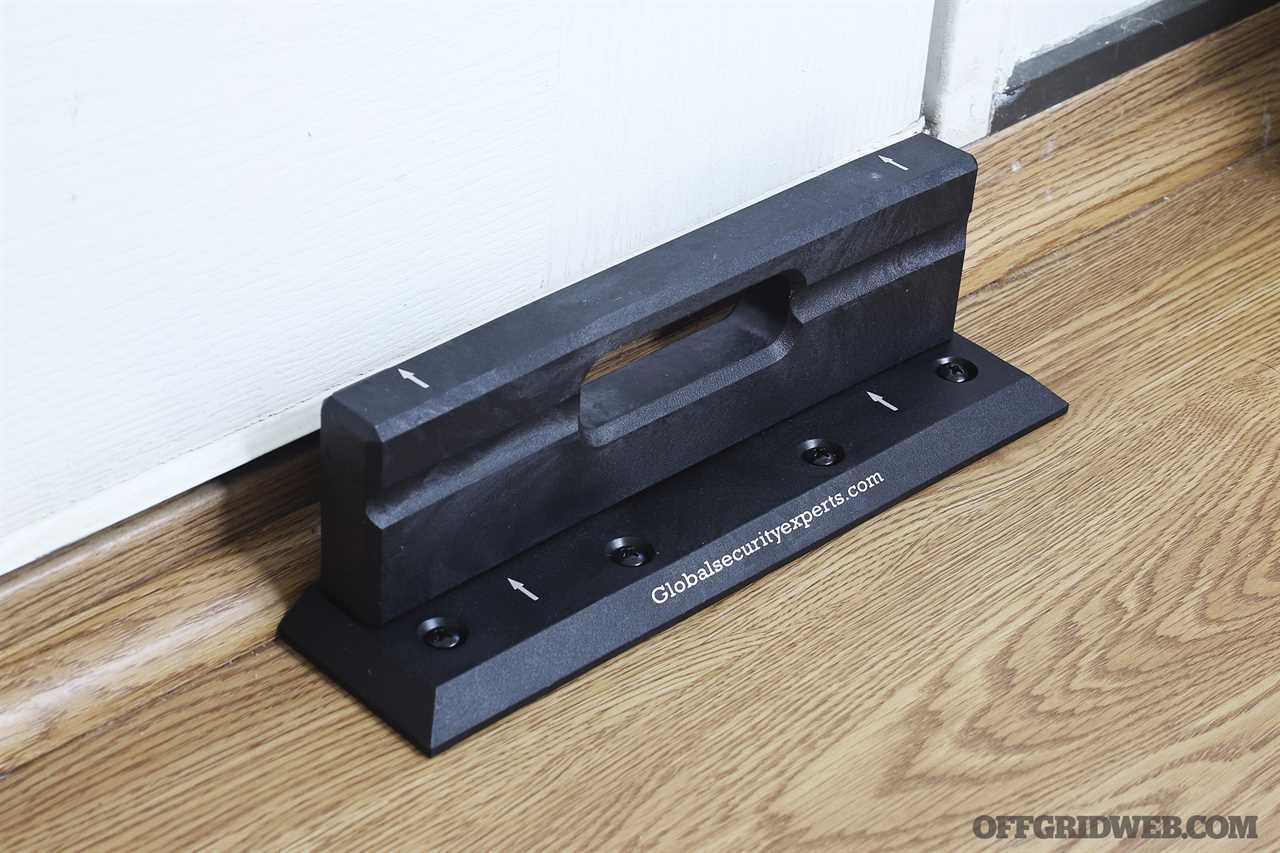
Above: Once in place, the OnGARD provides substantial reinforcement to your door.
Notes:
If you’re serious about beefing up the physical integrity of your exterior doors, this product deserves a hard look. Its simple, two-piece construction consists of a base plate with two elongated slots in it and a top plate with two matching extended tabs. To install it, position the base plate near the knob side of an inward opening door and, using the included drill bit, driver, and screws, anchor it securely to the floor. Then, with the door closed, simply insert the tabs of the top plate into the slots of the bottom plate and you’ve got a brutishly strong barrier. Injection molded from glass-fiber-reinforced polyphenylene sulfide, the OnGARD will withstand 3,100 pounds of force.
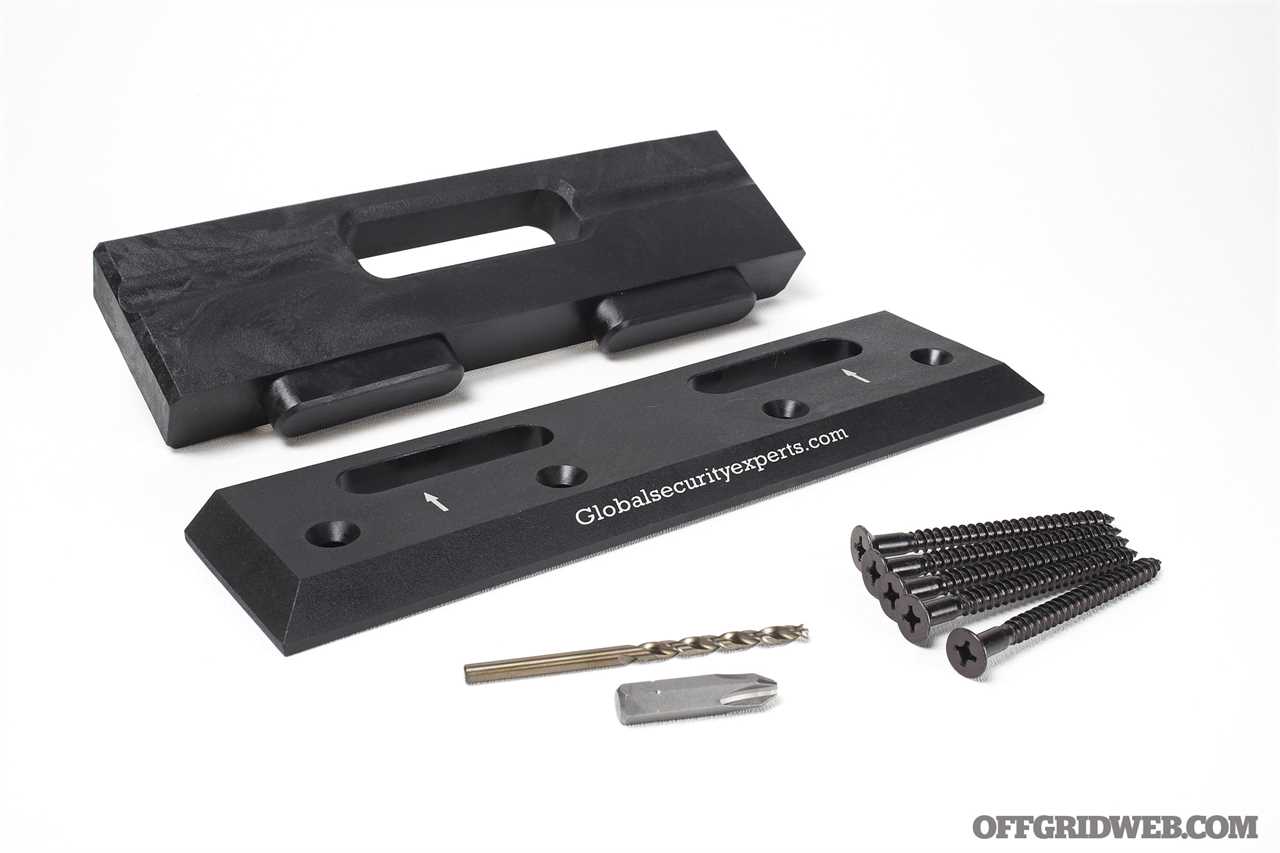
Above: The OnGARD is an extremely strong physical barrier that consists of a base plate that must be screwed to the floor and a top plate that fits into it.
Like wedges and other door reinforcements, the ultimate effectiveness of this device depends heavily on the structural integrity of the door itself. However, it offers a significant advantage. While wedges either require some space under the door or must be positioned slightly away from the door as a second layer of defense, the OnGARD butts flush up against the closed door. This not only makes it stronger, but is an advantage in cold climates and with doors that have weatherstripping at the bottom.
Master 265DCCSEN Security Bar
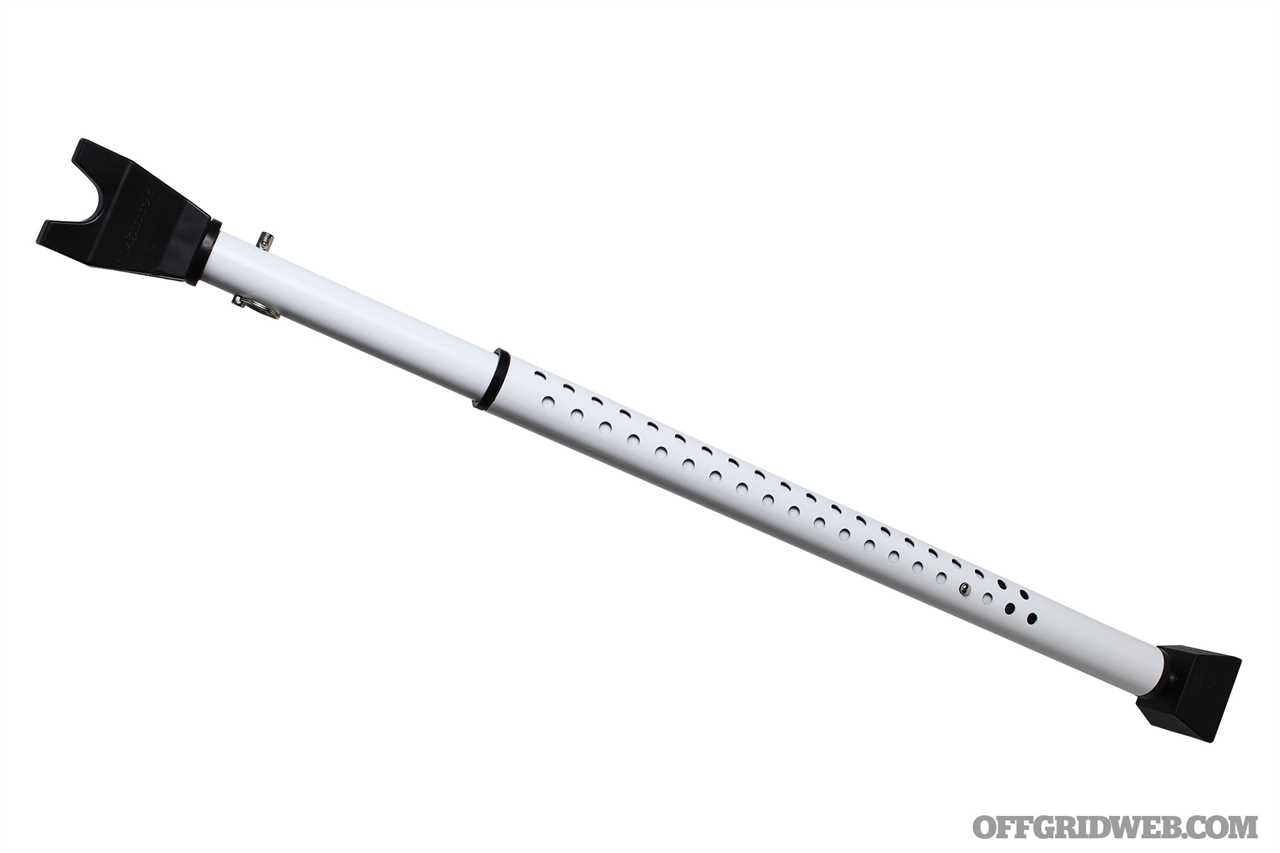
Above: The Master Security Bar is an inexpensive, adjustable, and extremely versatile security device.
Category: Physical Barrier
Dimensions: Adjusts from 27.5 inches (70cm) to 42.0 inches (1.1m)
Weight: 35 ounces
Price: $35
URL: masterlock.com
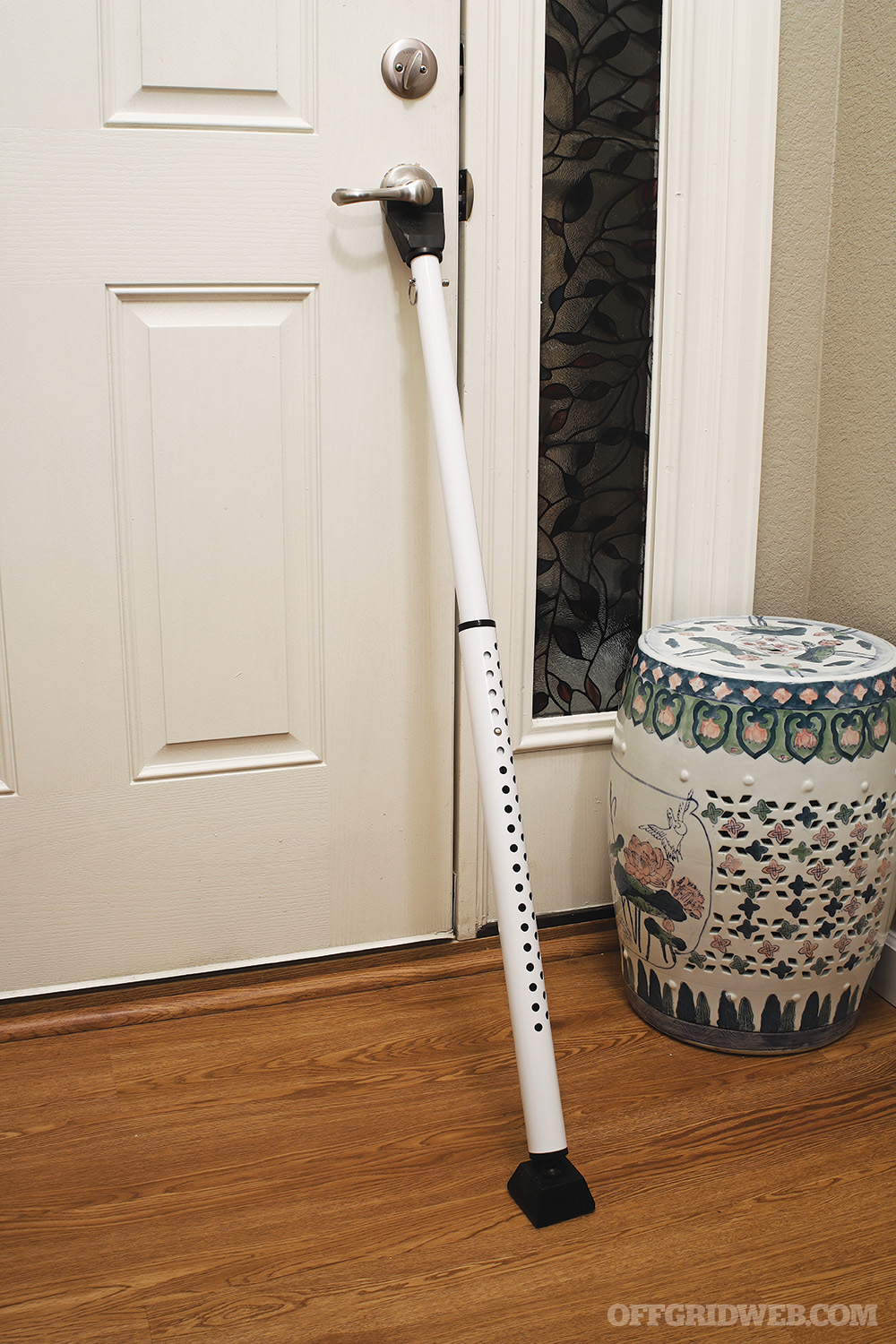
Above: Wedged under the doorknob of an inward-opening door, the Master Security Bar offers serious reinforcement and, unlike wedges, directs it to the middle of the door.
Notes:
Made from tough 20-gauge steel, this versatile product offers two different functions: a security bar for inward opening doors and a “Charley Bar” for sliding patio doors. With its U-shaped head attached, it wedges between the floor and the underside of the doorknob of a door to create an extremely strong barrier. Unlike door wedges or even the sturdy OnGARD device, which absorb all the force of an attempted breach at the bottom of the door, this device effectively reinforces the area of the door near the doorknob and lockset. This is also the area most likely to bear the brunt of an attempted kick-in, so its strength is better focused than floor-mounted devices. By pulling a single spring-loaded pin, the U-shaped head can be removed to transform it into a straight “Charley Bar.” Placed between a patio door and the doorframe, it makes sliding the door open impossible.
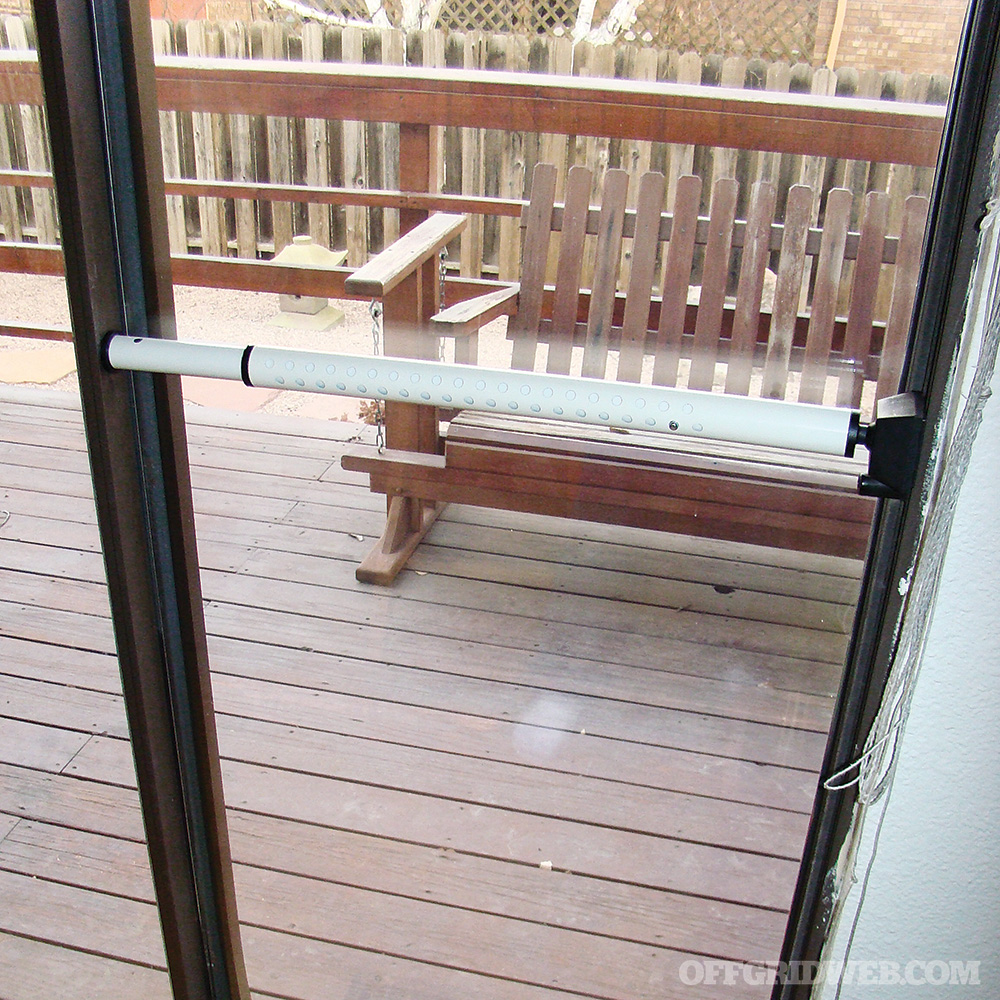
Above: By removing the Y-shaped head and adjusting its length, the Master Security Bar can also be used to secure sliding patio doors.
The base of the Master Security Bar has a pivoting ball joint that allows it to automatically lay flat and a non-slip rubber base that will not scratch floors. A push-button plunger and a series of holes allow it to be easily adjusted to the perfect size for practically any door in your house. Although this device still relies on the strength of the door it’s supporting, its design reinforces it in a more substantial way and does not require any space between the door bottom and the threshold. It is ideal for renters who can’t make changes to the structure of their home as well as homeowners who want to amp up the strength of their perimeter doors. It’s even light and compact enough for travel in checked baggage.
General Electric Door Stop Alarm
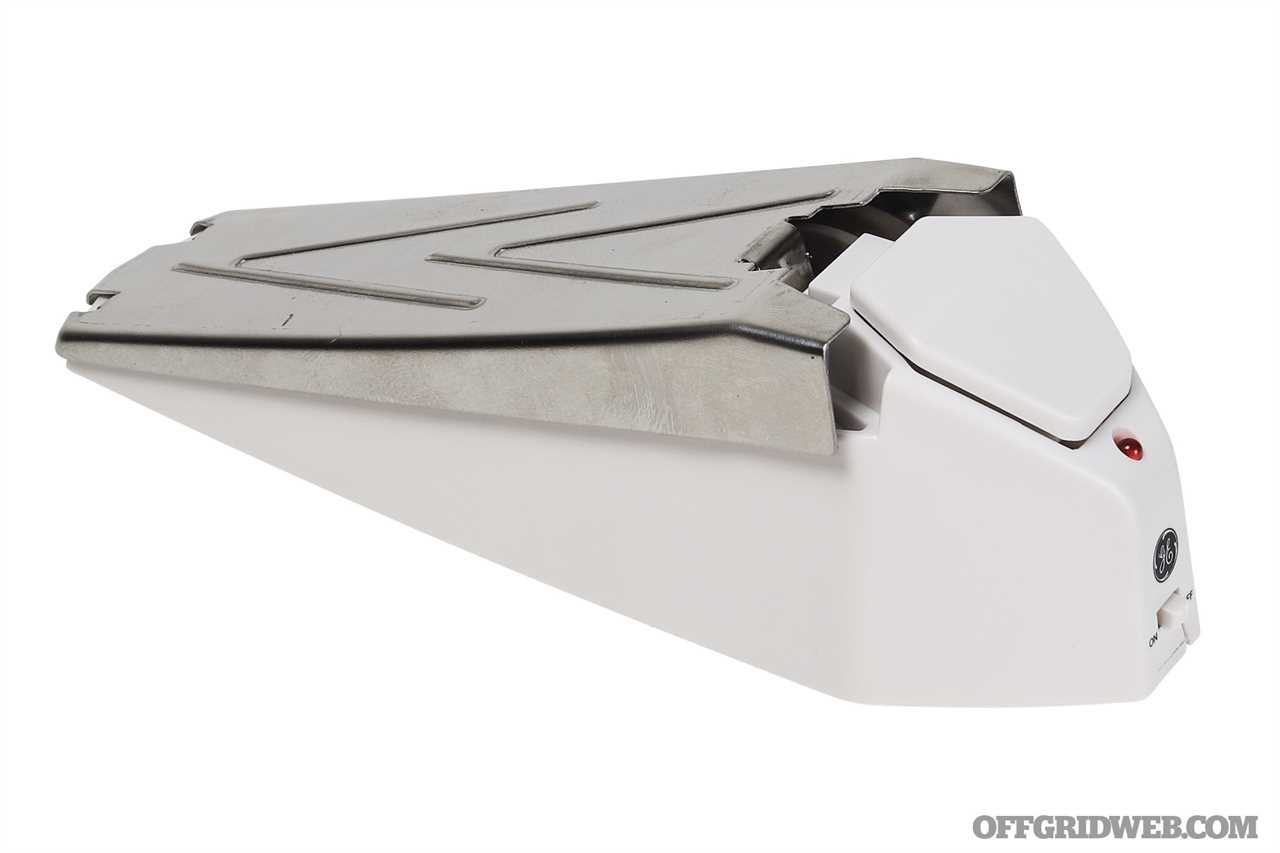
Above: The GE Door Stop alarm combines a door stop with a pressure-sensitive audible alarm.
Category: Overt Alarm/Physical Barrier
Dimensions: 5.90 by 1.89 by 1.77 inches
Weight: 3.4 ounces
Price: $14
URL: amazon.com
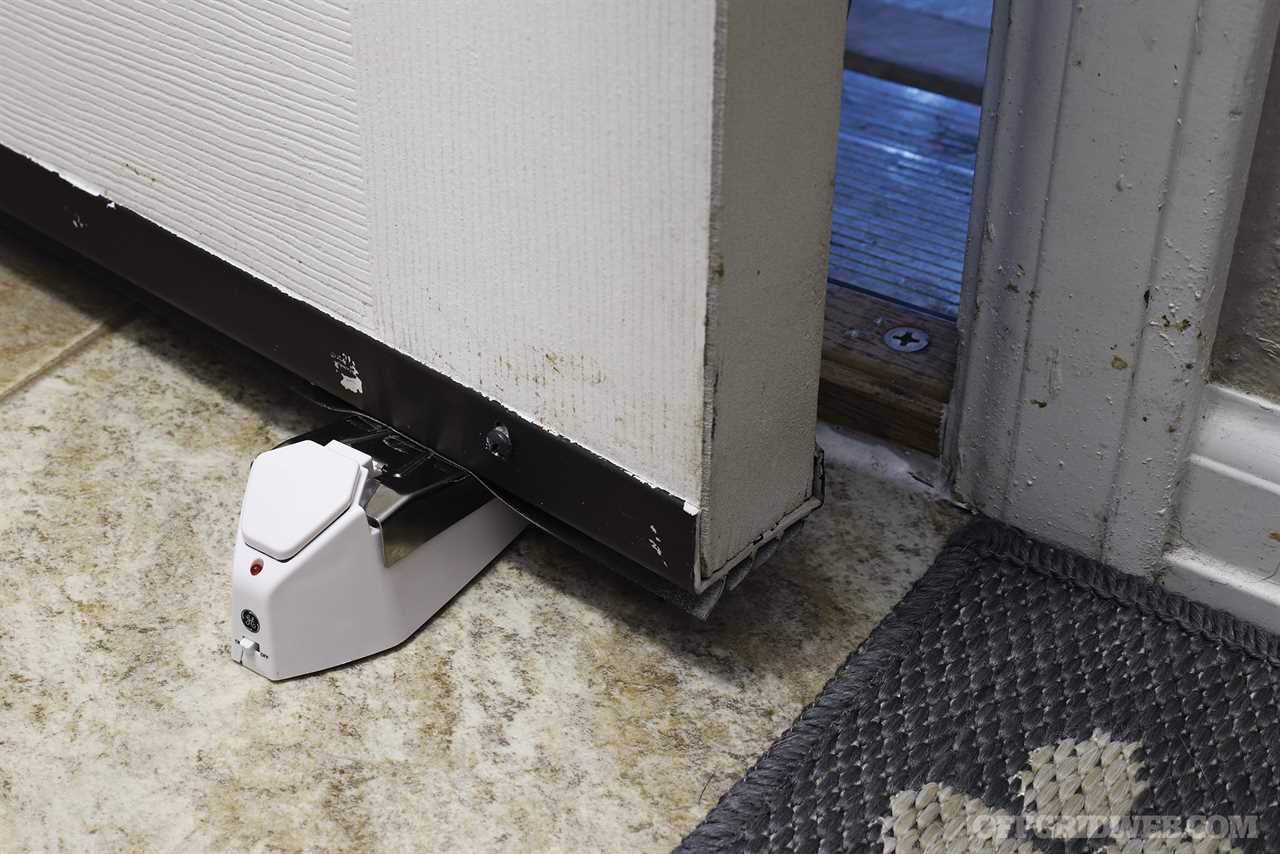
Above: While the GE Door Stop Alarm definitely works as an alarm, as a physical barrier it leaves a lot to be desired. On tile floors, a hard push of the door just moved it aside.
Notes:
The concept of this product is to combine the physical barrier function of a doorstop with a pressure-sensitive switch and an ear-piercing 120dB alarm. If a would-be burglar or home invader is able to overcome or bypass the lock(s), as the door opens, it depresses a switch plate on the top of the device to trigger the alarm. If the alarm itself isn’t enough to scare off the intruder, it gives you an early warning while the doorstop supposedly buys you some time to get your defense plan into action. While this sounds great in theory, the plastic construction of this unit is not as robust as a dedicated doorstop. Unlike a standard doorstop, it also cannot be wedged under a completely closed door without setting off the alarm and must be set back from the door. Although it has a rubber base that is supposed to add to its effectiveness as a barrier, when placed on a smooth floor, the opening door simply pushed it out of the way. Yes, the alarm went off, but the doorstop did little to keep the door from opening. As soon as the pressure on the device’s switch is removed, the alarm also goes off instantly. As a backup security measure in hotels, dorm rooms, and other dwellings where it’s possible someone else might have a key to the door, this device makes sense. In those environments, there are also more people around to hear the alarm. As a perimeter defense measure for a single-family home, however, it’s of very limited use.
General Electric 4 Window/Door Alarm
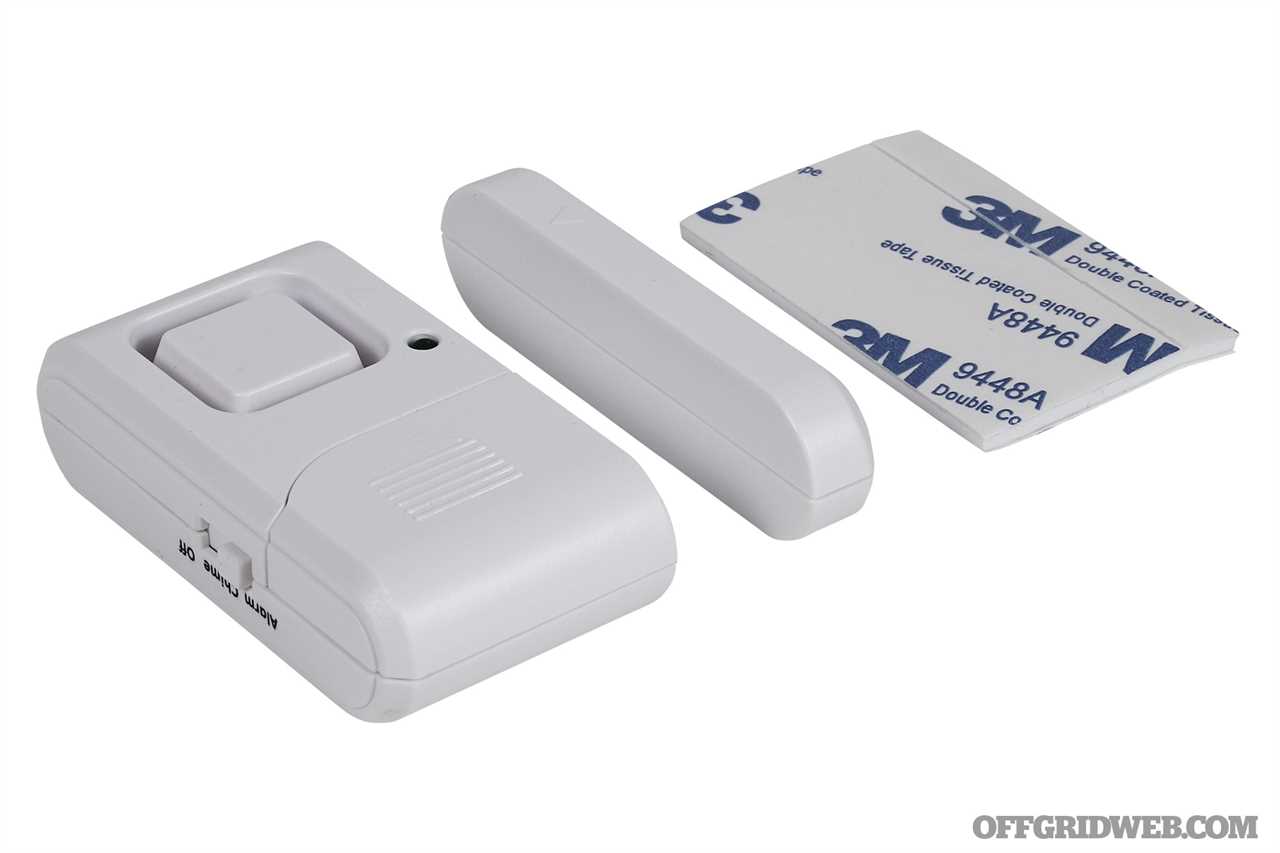
Above: GE’s stick-on alarms can be used to easily alarm almost any door or window, but your reaction time to the breach had better be quick.
Category: Overt Alarm
Dimensions: 2.37 by 1.62 by 0.63 inches
Weight: 1.3 ounces
Price: $21
URL: amazon.com
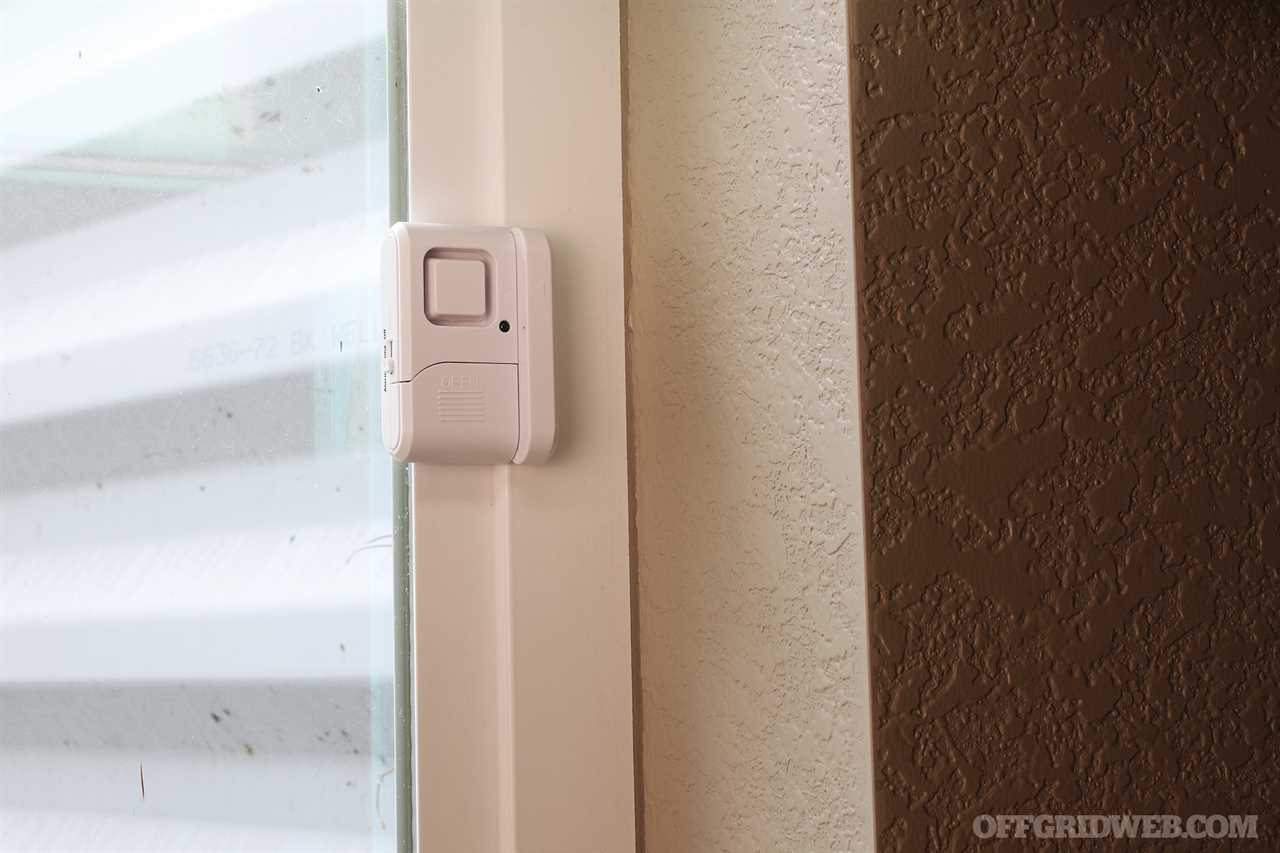
Above: A GE alarm installed on a basement window. Ideal for apartments and rental homes, it leaves no permanent marks when removed.
Notes:
These standalone alarms are designed to work on just about any door or window. They consist of two pieces: the body, which contains the alarm circuitry, speaker, and a reed switch, and a second piece that contains a small magnet. Both pieces mount quickly and easily with double-sided foam adhesive strips that are included with the alarm. To use, simply stick the foam tape to the back of the alarm pieces and attach the alarm and its companion magnet component side by side — one on the door or window itself and the other on the adjacent frame. The two pieces must be positioned so they are immediately beside each other when the door or window is closed. When the alarm is armed, the magnet component keeps the reed switch in the alarm body open. However, if the magnet is moved away from the alarm body by opening the door or window, the reed switch closes, completes the circuit, and triggers a 100-decibel alarm. Sold as a four pack, these inexpensive alarms can be quickly and easily installed in apartments and rental properties without any permanent effects to the structure. They are powered by four LR44 button batteries (included) and are impressively loud for their size. That’s good, since they are true stand-alone alarms and do not communicate with a central control panel. While they do give you an early warning if a door or window is breached and may be enough to scare off an intruder, if he’s thinking quickly, he can simply flip the switch and turn off the alarm once he’s inside. As such, this type of alarm must be paired with a sound and very determined quick-reaction plan.
Kitfox Outfitters Cyalume Surface Trip Flare
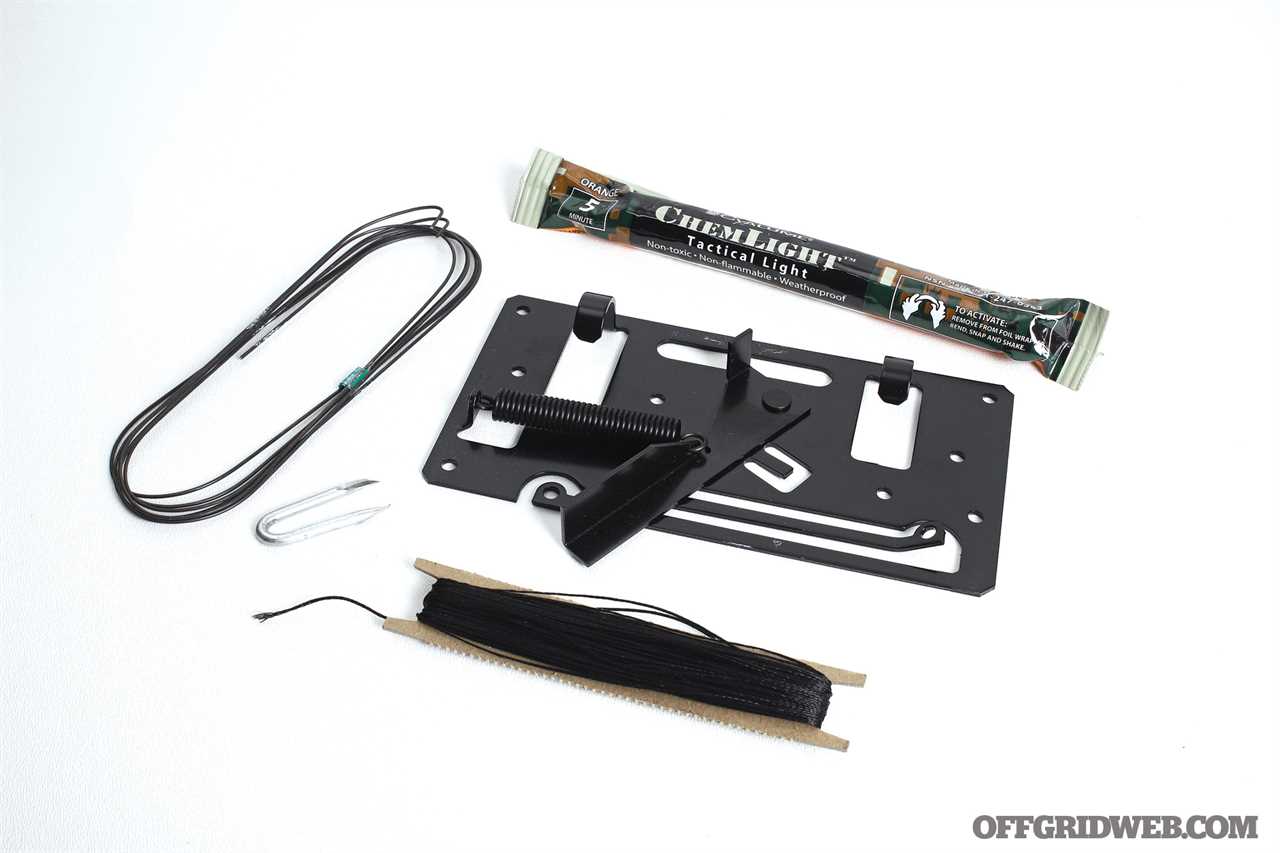
Above: The Cyalume Surface Trip Flare is a trip-wire-triggered device that breaks and activates a Chemlight as a visual signal of a perimeter breach.
Category: Overt Alarm
Dimensions: 7.00 by 3.6 by 0.77 inches
Weight: 10.6 ounces
Price: $25
URL: kitfoxoutfitters.com
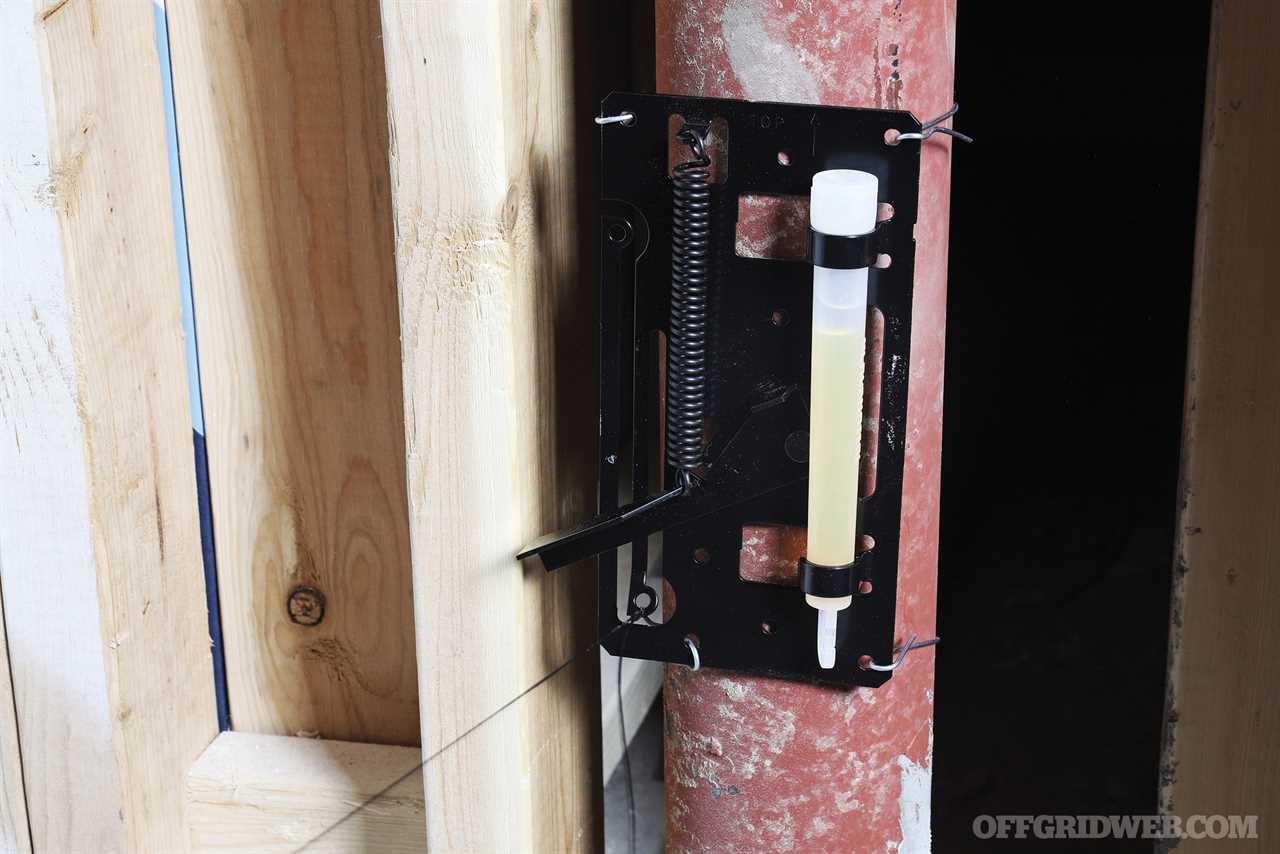
Above: The Cyalume Trip Flare set and ready.
Notes:
This device is a non-pyrotechnic version of the old-school military trip flare. The classic versions, like the M49, consisted of a chemical flare that was initiated by a pull fuse. The flare would be anchored to a solid object along the perimeter and a trip wire strung from the fuse across a likely avenue of approach. When an intruder hit the trip wire, it triggered the flare which erupted into a spectacular flame for a few minutes and let everyone know there was someone “in the wire.” The Cyalume version works basically the same way, but rather than triggering a pyrotechnic, it features a spring-loaded striker arm that breaks and activates a high-intensity Chemlight light stick.
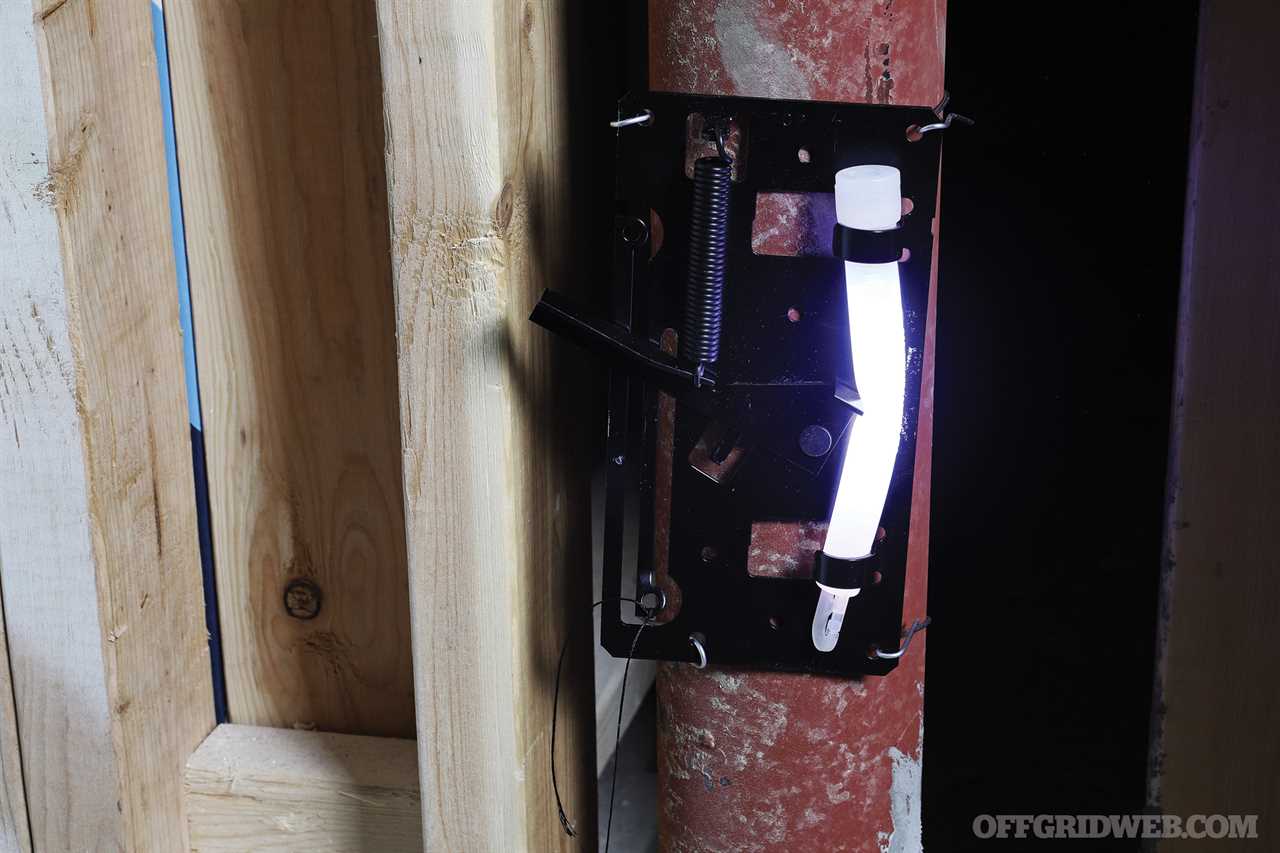
Above: Here's what the Cyalume Trip Flare looks like once it's activated.
While the Cyalume Trip Flare doesn’t pose the fire hazard of a pyrotechnic flare, it is also not nearly as bright, as obvious, or as easily seen from a distance. Very importantly, it’s only useful when you are actively scanning for a potential breach of your perimeter defenses, either visually or with the aid of security cameras. Also, since the flare’s trip line is of limited length, the intruder is very likely to see the Chemlight when it’s activated. Unlike a burning flare, which is difficult to snuff out, it’s not difficult to cover a Chemlight so it can’t be seen. One way to thwart that possibility would be to use an infrared Chemlight in conjunction with night-capable security cameras, but you’d still have to be looking at the cameras when the flare is tripped to get the benefit of an early warning. Although this device is well made, functions as intended, and actually has a military NSN, unless you and your family regularly walk patrols around your house at night or do guard shifts in front of your security camera monitor, it won’t do you much good.
Shomer Tec Infrared Perimeter Protector
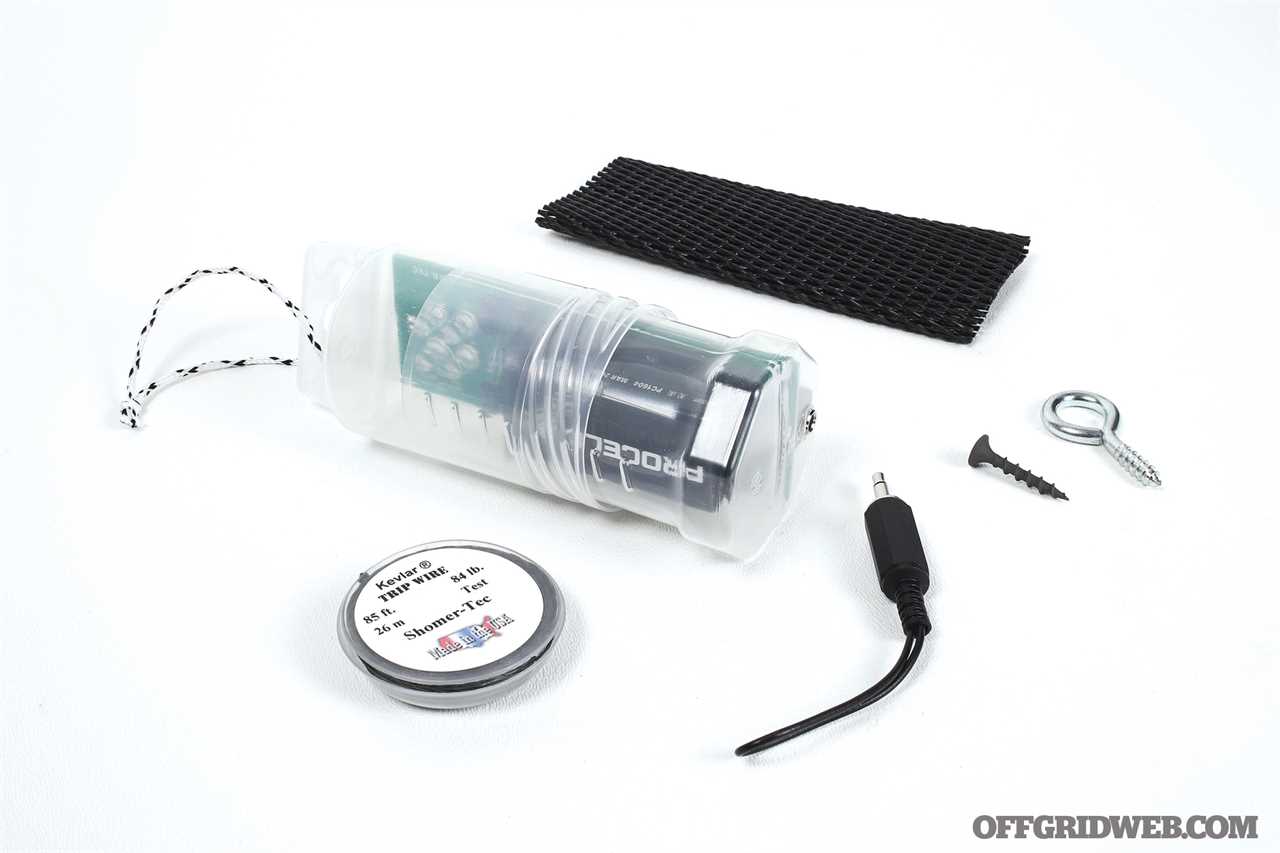
Above: The Infrared Perimeter Protector is basically a hi-tech electronic trip flare that can only be seen by night vision devices.
Category: Covert Alarm
Dimensions: 5.0 by 1.9 inches
Weight: 10.6 ounces
Price: $79
URL: shomer-tec.com
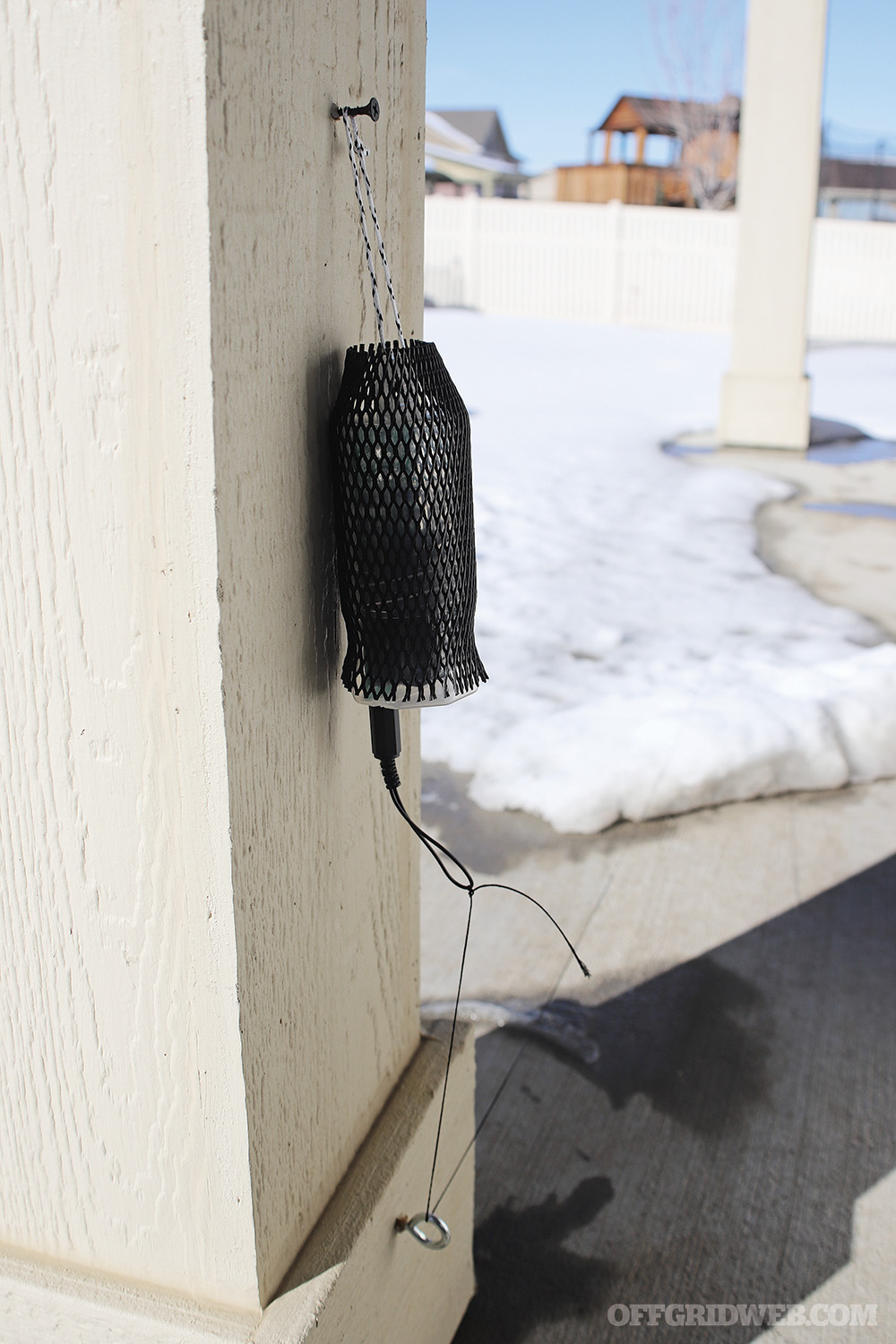
Above: The Infrared trip flare set and ready to go. Note how the trip line runs through the eye screw and up to the device’s “pin.”
Notes:
The Infrared Perimeter Detector is an even more modern take on the classic military trip flare. It consists of a two-piece, plastic, weatherproof body that contains a small electronic circuit board and a 9-volt battery. A hole in the bottom of the body allows a 1/8-inch mini-plug — like the one at the end of your headphones — to be inserted into a receptacle on the circuit board. When the plug is removed, it triggers the device and activates an infrared strobe. To set the device, it is hung from a tree or other solid object and camouflaged with a plastic sleeve. An eye screw is inserted below it and the Kevlar trip line is threaded through the eye screw and up to the mini-plug trigger. The other end of the trip line is then strung across a likely avenue of approach. The Perimeter Protector’s 940nm signal is invisible to the naked eye but can be clearly seen with night vision scopes and low-light cameras. It is visible up to a mile away with Gen 3 night vision and produces a distinctive pulse rate that makes it easy to distinguish from other ambient light sources. Made in the USA, it comes complete with mounting hardware, an 85-foot spool of Kevlar tripline, a camouflaging sleeve, and a battery. Although it works exactly as advertised and is readily visible on the night-capable cameras of the average home security system, you still have to be looking at those cameras for the device to give you an edge as an early-warning alarm. For applications where there’s a living, breathing human staring at a security camera monitor or scanning the perimeter defenses with NVGs, this device makes sense. For civilian home security, it’s not very applicable.
FITH Ops Alarm Signaling Device
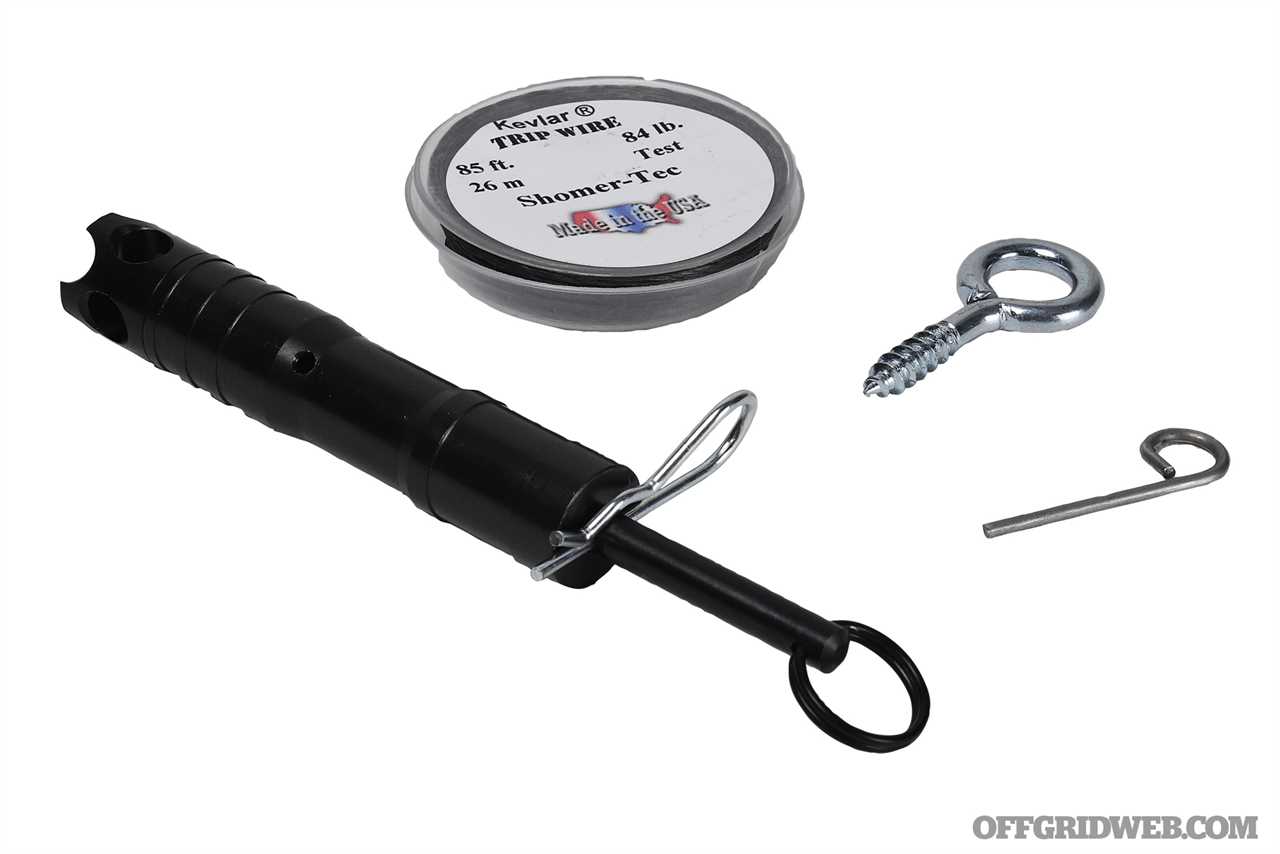
Above: The Alarm Signaling Device is a trip-wire-activated audible alarm that fires a shotgun primer.
Category: Overt Alarm
Dimensions: 3.8 by 0.54 inches
Weight: 1.3 ounces
Price: $25
URL: shomer-tec.com
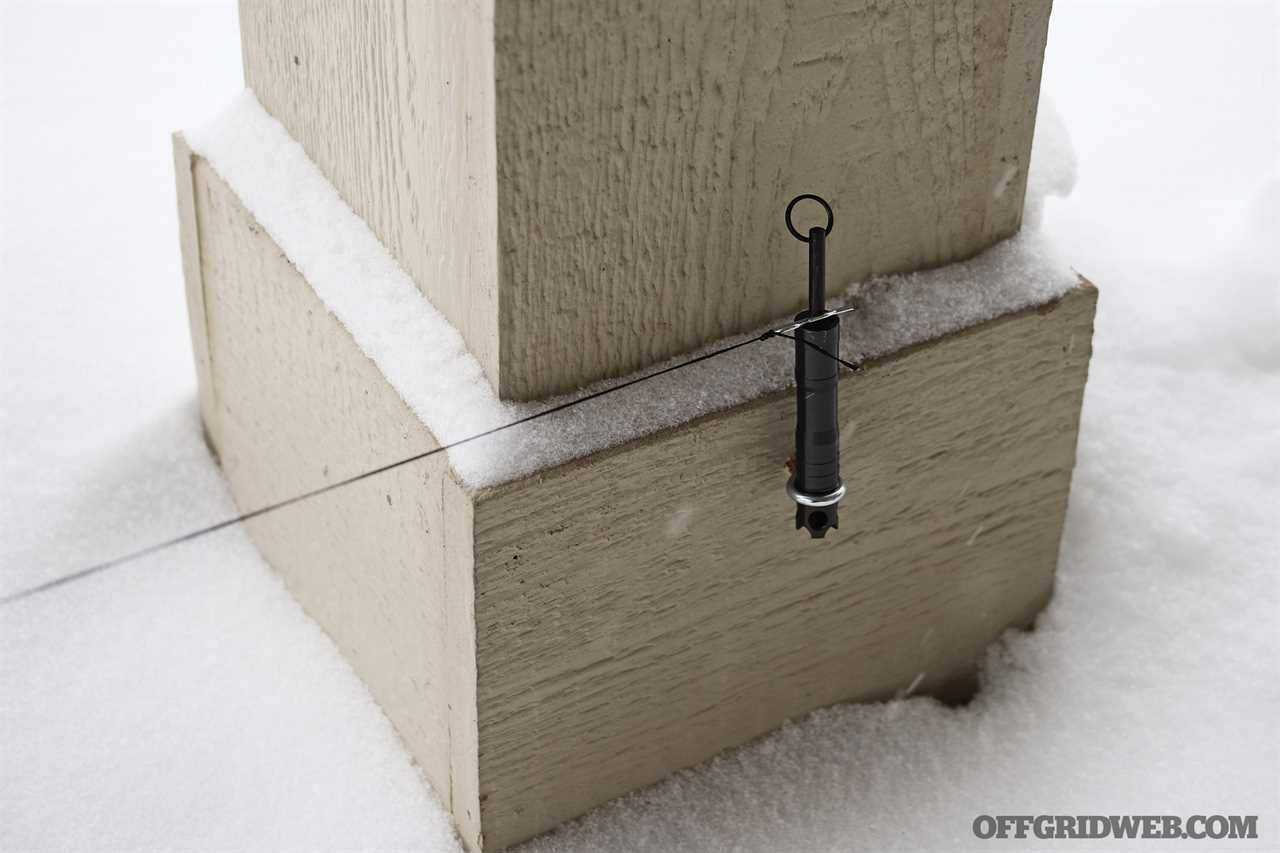
Above: The Alarm Signaling Device in place and ready to do its job.
Notes:
The Alarm Signaling Device is basically an audio version of a trip flare. It consists of an aluminum body with a threaded “muzzle brake” plug, a spring-loaded striker, and a grenade-style pull pin. The threaded plug unscrews to accept a standard 209 shot shell primer and serves as an “anvil” to fire it. To set the device, cock the striker and insert the trigger pin and the back-up safety pin in their respective holes in the striker shaft and the body. Mount the device to a tree, fencepost, or similar solid object in a vertical position with the striker pointing up. Attach a trip line to the trigger pin and string it across a likely avenue of approach. Unscrew the end of the body, insert a 209 primer, and screw the end back into place. Finally, remove the safety pin to arm the device. When the trip line is pulled, the trigger pin slides out of the striker shaft and the spring drives it home to fire the primer. Nicely machined from high-quality aluminum and steel and sporting a non-reflective coating, the Alarm Signaling Device is a well-made piece of kit that is manufactured in the USA. Unlike visual trip-wire devices, the gunshot-like “crack” it produces is much more likely to get your attention and provide a true early-warning signal. It also sends a strong message to an intruder that he’s lost the element of surprise and that someone — potentially someone well-armed — is waiting for him. As such, it offers a significant deterrent effect as well. Versatile and reusable, this device cannot only be strung across paths and entry zones but can also be attached to remote gates and doors. The Alarm Signaling Device includes the device itself, an eye screw for mounting it, trigger and safety pins, and an instruction card. The primers and trip line must be purchased separately. Easy to install, this device can be used very creatively and provides both a true early-warning signal and the deterrence of an automated “warning shot.”
Related Posts

A Quick Look at Smartphone Security AppsWe looked at a few smartphone security applications that can help you protect yourself, your data, and your hard-earned currency.

Faraday Bags: Testing Commercial and DIY Wireless Signal BlockersFaraday bags can block various types of signals from communicating with electronic devices, including GPS, cellular, Bluetooth, and Wi-Fi.

DIY Disinfectants: How to Fight Diseases with Limited ResourcesStrict attention to hygiene and use of disinfectants, both off-the-shelf and improvised, will save many lives in the aftermath of a disaster.

Preparedness Lessons from the Uvalde Mass ShootingPrior to the mass shooting, Uvalde had been like any city in America, not yet a statistic. A disturbed 18-year old changed that forever.

Pocket Preps: IFAKs for Everyday CarryThe IFAK (Individual First-Aid Kit) has been a standard military item for generations and has become common with other first responders.

New: Bushnell BackTrack Mini GPS UnitThe new Bushnell BackTrack Mini GPS unit offers navigation, weather tracking, and Bluetooth connectivity at an affordable price point.

Midland MXT575 GMRS Mobile Radio Review & DIY InstallationThe new 50-watt Midland MXT575 GMRS mobile radio can easily connect to repeaters, mobile radios, and cheap Baofeng handhelds I already own.

Preparedness Lessons Learned from the Invasion of UkraineAs preparedness-minded individuals, there's much we can learn from the ongoing conflict in Ukraine. Take a moment to consider these lessons.

Improvised Antiseptics for Preventing InfectionWith a little knowledge and imagination, improvised antiseptics can help the family medic decrease the risk of infection, even off the grid.
The post Buyer’s Guide: Perimeter Defense Tools for Home Security appeared first on RECOIL OFFGRID.
By: Offgrid Staff
Title: Buyer’s Guide: Perimeter Defense Tools for Home Security
Sourced From: www.offgridweb.com/preparation/buyers-guide-perimeter-defense-tools-for-home-security/
Published Date: Mon, 11 Jul 2022 11:00:32 +0000
------------------------
Did you miss our previous article...
https://bushcrafttips.com/bushcraft-news/using-a-van-as-a-bugout-vehicle
 What is BushcraftSurvival SkillsToolsVideosBushcraft CampsBushcraft KitsBushcraft ProjectsPrivacy PolicyTerms And Conditions
What is BushcraftSurvival SkillsToolsVideosBushcraft CampsBushcraft KitsBushcraft ProjectsPrivacy PolicyTerms And Conditions
